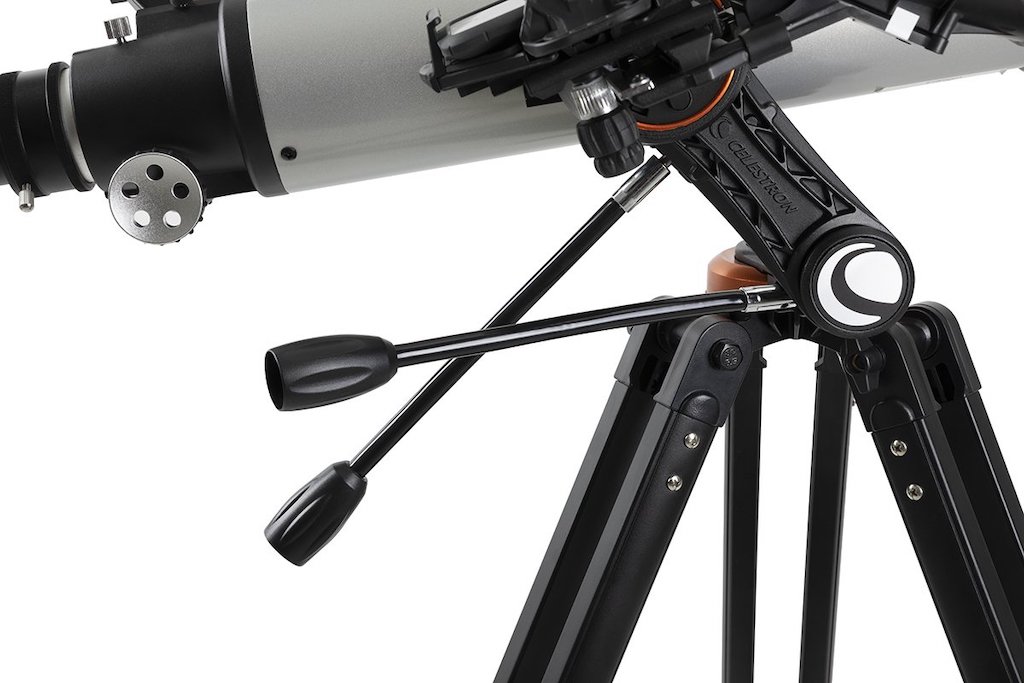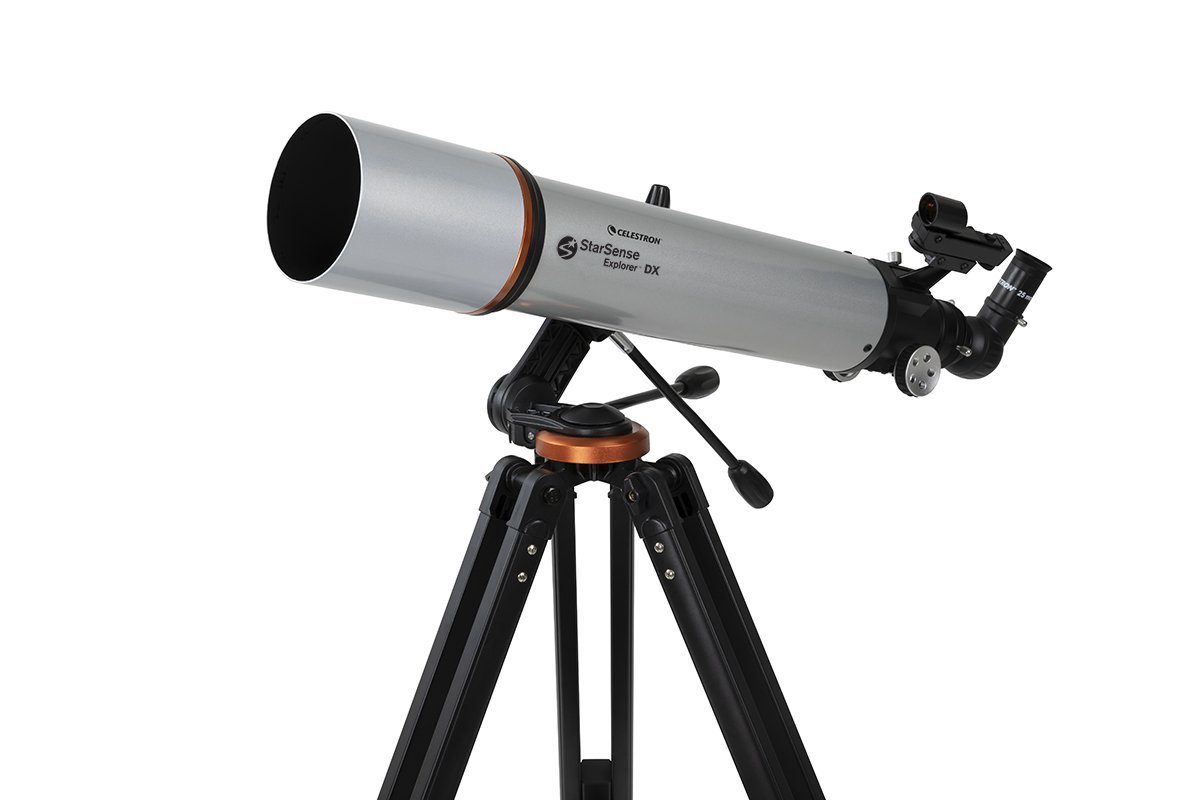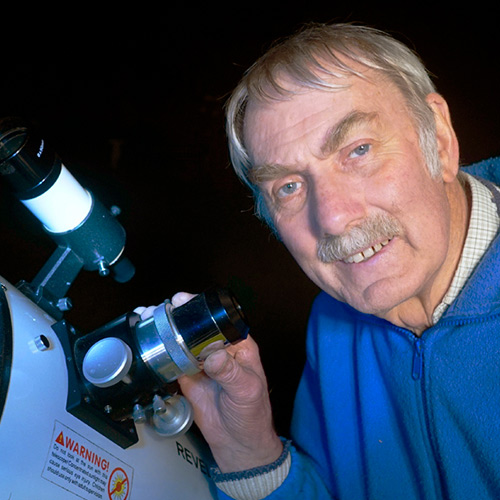Space Verdict
With the Celestron StarSense Explorer DX 102AZ, which links the telescope to modern mobile phone technology and computing power, Celestron has made locating objects in the sky not just easy, but fun — especially for those just starting out in a skywatching hobby. However, the system has a few notable limitations that could curtail observing sessions. The prowess of the instrument is more suited to beginners than to dedicated observers.
Pros
- +
Very easy and quick to find objects
- +
Intuitive push-to method of homing in
- +
Excellent on-screen information
Cons
- -
Alignment procedure depends on a mirror, which collects dew
- -
Slow motions are somewhat clumsy
- -
Instrument is stiff to move without slow motions
Why you can trust Space.com
The Celestron StarSense Explorer DX 102AZ offers access to the myriad targets that grace our night sky, but can be tricky to locate if the astronomer is just starting out in skywatching. The instrument is computerized, making use of the observer's smartphone and free-to-download StarSense Explorer app to make navigating the night sky and exploring solar system and bright deep-sky objects such as nebulas, star clusters and galaxies fun and, above all, a breeze to find.
The initial advent of computerized star catalogs, which were loaded into telescope handsets, made it possible to align a telescope on the sky by pointing it at just three bright stars. Once done, the handset was able to direct the telescope to any other object in its database, but it needed position encoders on its axes. All of this requires some user input — namely the date and time, the location, and choosing the stars.
Optical design: Achromatic refractor
Aperture: 4” (102 mm)
Focal length: 25” (660 mm)
Focal ratio: f/6.5
Highest useful magnification: 240x
Lowest useful magnification: 16x
Total kit weight: 14.2 lbs. (6.44 kg)
Mount type: Alt-azimuth
Then along came “plate solving” — the software to identify a field of view of stars in a photograph — and the great computing power, position sensing, and imaging capabilities of a modern smartphone. With the StarSense Explorer line of instruments, Celestron’s magic solution has been to link these to a telescope, getting rid of the need for the costly handset, the user input, and the encoders. Its StarSense technology links a smartphone to a telescope in a simple, yet robust fashion.
What's more, the instrument comes with everything you need for a night under the stars: two eyepieces — a 25 mm and 10 mm, which offer magnifications of 26x and 66x — a StarPointer red-dot finderscope, star diagonal and tripod.
Celestron StarSense Explorer DX 102AZ review: Design
- Achromatic refractor on alt-azimuth mount
- Manual slow motions with flexible rods
- Telescope attached using standard dovetail
- Removable dock for user-supplied smartphone
- Two eyepieces and erect-image diagonal
- Red-dot finder

There are four instruments in the Celestron StarSense Explorer range: an 80 mm refractor, a 114 mm reflector, the 102 mm refractor under test, and a 130 mm reflector. All these instruments are standard members of the Celestron range and are available in other mounting packages. In this range, the 80 mm refractor and 114 mm reflector are supplied on lighter-weight mountings, while the 102 mm refractor and 130 mm reflector have the same heavier mounting.
Because all these mountings use a standard Vixen-type or CG-5 dovetail attachment, you can attach any other instrument that uses the same dovetail, taking into account the load capacity of the mounting.
The alt-azimuth mounting means that you can move the instrument around two axes – up and down (altitude) and from side to side (azimuth). This is the simplest form of mounting and is particularly suitable for a beginner’s instrument. The alternative equatorial mounting, which has one of its axes tilted at the same angle as your latitude, not only confuses the wits out of many beginners but has a drawback in that it involves an overhanging load usually balanced with a counterweight, reducing the portability.
Breaking space news, the latest updates on rocket launches, skywatching events and more!
The mounting of the Celestron StarSense DX 102AZ is completely manual, with flexible rods to allow what are called slow motions, to provide finer control over the movement than simply pulling and pushing the instrument. The extra ingredient over a standard manual mounting is the attachment for a smartphone, directly fixed to the central assembly. This is not to be confused with smartphone attachments that simply enable you to take photos of bright objects through the eyepiece, as found on some other beginners’ instruments.

The Celestron StarSense Explorer DX 102AZ is an achromatic refractor, with a 102 mm doublet lens composed of two different types of glass. It has a focal ratio of f/6.5, which means that it has a comparatively short tube for its diameter — a situation that provides a wide field of view and bright image with a fairly compact instrument.
The word “achromatic” implies a freedom from the false color that bedevilled refractors in the very early days of telescopes, but this is a comparative term. Like other achromatic refractors, the Celestron StarSense Explorer DX 102AZ still has some false color, which reveals itself as colored fringes around the edges of objects, particularly at high magnification, and the short tube results in inherently more false color than with a longer focal-ratio achromatic instrument. To completely overcome false color you need a considerably more expensive apochromatic refractor or a reflector. However, refractors are traditionally more robust than reflectors, so there is no ideal instrument to suit everyone.
The package comes with two eyepieces, giving two useful magnifications of 26x and 66x, and what is termed an erect-image diagonal. A star diagonal is standard with astronomical refractors and reflects the beam from the focuser through 90 degrees to allow a much easier observing position than crouching on the ground looking up through the tube, but usually, it has the drawback of reversing the image as in an ordinary mirror. The diagonal provided by Celestron uses a roof prism rather than a simple mirror, giving a non-reversed image so you can use the instrument by day as well as by night. It also avoids the confusion of viewing the moon’s features or star fields back to front.
Finally, there is a standard red-dot finder to help in pointing the telescope at objects. This is necessary when aligning the telescope, as you need to point it at a recognizable object at the start of observing.
Celestron StarSense Explorer DX 102AZ review: First light and functionality
- Simple assembly — once you know what to do
- Quickest-ever alignment on the sky
- Intuitive push-to system for finding objects
- Mirror can dew up quickly, terminating your session

The instrument comes in just two main parts — the tripod and the tube assembly — so it seems straightforward to assemble. The accessory tray that sits in the middle of the tripod legs, however, needs to be attached by fiddly little thumb screws that are already in place — but the wrong way round in their holes! Why use such a time-consuming means of attachment? A poor design, as these screws will quickly get lost. A simple slot-and-turn system would be much less aggravating for astronomers, unless you intend to use the instrument solely as a piece of furniture permanently set up in the corner of the room — or do without the tray altogether.
The telescope attaches to the mount using a standard dovetail, but as it came out of the box the clamp assembly was twisted through 180 degrees, with the locking screw at the bottom. The instructions tell you to turn it, but this is easier said than done. It seems immovable, and many beginners will wonder if they are meant to be forcing this round at all. In fact, you do need to apply a lot of force to twist it. Confusingly, the instructions then refer to the knob at the bottom of the clamp!
The eyepieces are supplied with tight plastic covers — and how many beginners will try to twist these off, rather than prise them off? In instructions intended for raw beginners, points such as this are vital.
Once set up, you need to align the red-dot finder with the main instrument by day. Unfortunately, the adjustment range on the device supplied did not allow it to be aligned accurately, and for the test, we used another one that we already had.
The final step is to remove the cap from the mirror on the StarSense dock — again, courageously pulling off with some effort — and fitting your smartphone into the spring-loaded slider. Bear in mind that not all smartphones will work, so remember to check your model against a list on the Celestron website before taking the plunge. Your smartphone's camera must be sensitive enough to image the brighter stars on a night setting.

We're pleased to report that loading and using the software on our Moto G8 phone was easy and quite intuitive. This is fortunate, as the Quick Start manual ends at this point. All the following stages are accomplished using the StarSense app that you need to unlock using a code supplied with your instrument, which will work with up to five devices.
The camera views the sky through a mirror, enabling you to view the phone’s screen at a convenient angle. The StarSense app displays the camera’s view of the night sky, using a time exposure if necessary so it may take some seconds to appear or refresh. The method of alignment is to aim the telescope at a chosen object — which is where the red-dot finder comes in handy — and then move the red crosswires on the app to the same object shown on the phone view. You can zoom in for better precision.
Now you are in business and you can choose from a list of objects observable with this instrument at the time, graded according to whether they can be seen from the city or from a dark sky. Once chosen, you see a set of arrows on the screen that tells you which way to move the telescope to get to that object. Within seconds, you are on target and the cross wires turn green. Moving from one object to another takes just seconds — the quickest finding system we’ve seen.
Some drawbacks do become evident. The finding system is not always spot-on, so you need to be prepared to search for objects around the edge of the field of view. The clutch that holds the telescope in altitude, on the test model anyway, is fierce, so to move it you need to grasp the tripod firmly with one hand and wrench the tube up or down with the other as per the instructions. The altitude slow motion is equally stiff to turn, while the azimuth control had an annoying backlash.
One major source of problems is the mirror that is crucial to finding objects. The software constantly checks the alignment of the instrument and complains if it can’t see the sky, so snapping on the cover in between observations is not easy or ideal. The mirror can become dewed up within minutes on some nights — often the clearest. Unlike household mirrors, its reflective coating is on the front surface rather than the back, so regularly wiping it clear could result in damage to the coating. Unwary users are likely to try polishing it with glass cleaner or even abrasive solutions.
Optically the telescope is well up to standard for a short-focus achromatic refractor and is well-suited to deep-sky observing. The eyepieces supplied, although in lightweight plastic barrels, are of good optical quality. Boosting the magnification using a Celestron 2x Barlow lens revealed false color in lunar and planetary images, so this is not an ideal high-power or planetary instrument. The erect-image diagonal (which is necessary to allow the instrument to focus) introduces very little distortion, only marginally noticeable on a star image using a magnification of 130x.
Should you buy the Celestron StarSense DX 102AZ?
Although the Celestron StarSense Explorer DX 102AZ didn't make into our list of the best telescopes for 2021, it's still an excellent piece of kit for those just starting out in skywatching, especially those who are hunting for an all-inclusive package that's easy to use and makes navigating the night sky a breeze. Once you’re accustomed to the instrument, finding objects is extremely quick and fun. The optical quality is good for a telescope of this type, but for planetary observing a different instrument would be preferable, such as the 130 mm reflector in the same range.
The clunky movement and delicate optics could limit the usefulness of the instrument for more detailed observations, but the system certainly does get you observing within just a few minutes, unlike more advanced telescopes, thus overcoming one of the greatest hurdles that beginners face.
If this product isn't for you
The pricing of this instrument is not significantly less than that of the Celestron NexStar 102 SLT — the same instrument on a fully motorized mount, which has the great advantage of tracking objects for you. So whether you buy this model or opt for the full Go To version, or indeed the NexStar 130 mm SLT reflector, is a decision that you will have to make depending on your observing interests.
Robin Scagell is a lifelong astronomer. He began his working career with Kodak, back in the days of film, and then spent time observing from the Pic du Midi Observatory in the French Pyrenees. After a career that included making telescopes and editing a photography magazine, he became an author of popular astronomy books including Complete Guide to Stargazing, 101 Things to Spot in the Night Sky and Night Sky Atlas. He has made numerous TV appearances explaining astronomy news stories, and lectures aboard cruise ships. Robin is the Vice President of the Society for Popular Astronomy, and even has an asteroid named after him (24728 Scagell), but neither the asteroid nor Robin poses a threat to civilization as we know it.


